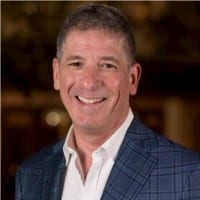 Jesse London has 25 years experience in media sales including stints in radio, TV and as a general manager at OUTFRONT and General Sales Manager at Clear Channel Outdoor. Today he talks about his background in out of home and how Liveboards change things for OUTFRONT. Jesse will share more ideas on out of home sales over the coming weeks. You can reach Jesse at jesselondon1@gmail.com.
Jesse London has 25 years experience in media sales including stints in radio, TV and as a general manager at OUTFRONT and General Sales Manager at Clear Channel Outdoor. Today he talks about his background in out of home and how Liveboards change things for OUTFRONT. Jesse will share more ideas on out of home sales over the coming weeks. You can reach Jesse at jesselondon1@gmail.com.
What did you do at OUTFRONT and Clear Channel?
I joined CBS Outdoor as General Sales Manager for Outernet, worked under Wally Kelly, opened dedicated offices in LA, San Francisco, Chicago and New York and managed place-based ad sales onto the TV’s in GameStop stores and grocery stores. This was a good business, we grew sales by about 200%, and it afforded me the opportunity to do deals with and spend time with some of the finest billboard people in the business. We did generated countless programs that bundled our digital out of home offering with billboards because we were able to execute the digital media market by market. I think for me once I touched the billboard business, I loved it, and when CBS did not move me to the mother ship, I went across the street to Clear Channel as General Sales Manager New York. At Clear Channel I was GSM for three offices – NY, NJ and Hudson Valley with 1600 static and digital faces. What a blast that was, we achieved our sales goals in every single quarter. I went back to Outfront NY because they recruited me heavily and because it was for the GM role. I knew the guys at Outfront from my work at CBS Outdoor, it was a $100 million business and it felt comfortable. We did good work there.

How do Liveboards change the sales process for a company like OUTFRONT
We didn’t see a significant process change, but the conversation changed. Liveboards are an exciting innovation, and I saw increased advertiser interest in the technology.
First, Liveboards provide scale. An advertiser can reach 35 million NYC subway riders weekly across 160+ subway stations. That number climbs to 45 million by this September when Liveboards hit 240+ stations. Liveboards are also in Boston, Washington, SF, and Miami. so that the reach this network offers is really off the charts. While the sheer size is impressive, when you combine that with the speed and ease of execution the value proposition changes. To deliver create print and post media in 160+ subway stations it used to take four weeks. Now it can be done in 24 hours. This is the beauty of a pure digital play – scalable, massive reach quick, with no lead time.
Second, the screens are brilliant, full motion (they look great), the images are always perfect, messages are targetable by station/neighborhood/borough etc. and it is flexible so that brands can move their ads from one station to another. Posting, changing copy, rotating, or layering in dynamic content across the Liveboards is as easy as it is for any operator to change out their digital billboard. The new digital interface now also gives the advertiser digital play reports.
The speed, scale, targetability, full motion, and accountability make Liveboards effective competition for money which might otherwise have been earmarked for digital and video. This allows sellers to expand the conversation beyond the buyer and now include Planning and client – this is significant, clients are paying more attention and the sales team is getting better engagement. To sell in the value of all outdoor, to facilitate better conversations, and to shift budgets to out of home from digital, Outfront created a second group of sellers called the Client and Agency Partnership (CAPS) team. Their role, in part, is to manage sophisticated idea generation across planning, strategy, creative, tech and account levels at the agencies, digital shops (a new target), and brands directly. They help to evangelize the new technology, shed light on advances, sell in this transformation, and they try to influence how that money is planned. So, increasingly the conversation and vocabulary has shifted to a more digital centric conversation; the sales organizations sees this product as not just smart out of home, but as a complement or alternative to digital.
[wpforms id=”9787″]
Paid Advertisement

















